Goa365
Sunday 14 August 2011
Top 10 Most Important Discoveries in Astronomy
Top 10 Most Important Discoveries in Astronomy
Astronomy is the cool, sexy field of the scientific world. Sure, biologists and chemists are out there curing diseases or whatever, but they’re just so boring. Meanwhile, astronomers are busy showing us sweet pictures of distant planets and playing around with telescopes the size of buildings. How can you compete with that? You can’t, so here are the ten most important things astronomers throughout the ages have discovered:
10. The Movement of the Stars and Planets

The Discovery
It’s tough to wade through a couple thousand years of ancient Babylonian, Egyptian, Greek, Indian, Chinese, Mayan and Persian astronomical history to pick out the highlights, so I’ going to cheat and roll all of their achievements up into one entry. Maybe if their civilisations hadn’t died out they would have got a better spot on this list, but because they couldn’t keep their empires together the ancient world gets stuck with the number ten spot. That’ll learn ‘em.
How Important Was It?
Many of their accomplishments form the basis of modern astronomy, but it’s the fact that they tracked the movement of the stars and planets that really got the whole ball rolling. The realisation that the stars in the sky follow fixed, predicable patterns, along with the discovery of planets that follow their own paths, are the two most basic, fundamental concepts of astronomy. And also astrology, an equally important field of study.
9. The Heliocentric Model

The Discovery
Astronomers had speculated about heliocentrism (the idea that the Earth revolves around the sun, not the other way around) since ancient times, but in 1543 Copernicus was the first person to actually demonstrate the math behind the idea to prove it was a viable concept.
How Important Was It?
It took a while for Copernicus’ model to become universally accepted. (Get it? Astronomy puns are so easy.) Once it finally took hold it formed the basis of a scientific revolution. It eliminated many of the problems caused by the old geocentric model (it’s tough to make accurate calculations if you think the Earth isn’t moving), making it the first major shift in the field of astronomy since people realised the sun was a star and not an angry God. Also, his discovery made us feel stupid for once thinking we were the centre of the universe. Thanks a lot, Copernicus.
8. Kepler’s Laws

The Discovery
In 1609, a German astronomer named Johannes Kepler told the world that planets moved around the sun on elliptical routes, not in perfect circles as was commonly believed. Yeah, you know science can be boring when ellipses instead of circles is one of its most important discoveries.
How Important Was It?
Elliptical movement means that the distance between the sun and any given planet changes over time, and that’s an important thing to recognise if you want to figure out how far away a planet is and how fast it’s moving (the closer it is to the sun, the faster it moves). Thanks to Kepler’s laws, astronomers were able to predict the motion of the planets with far greater accuracy than before.
7. The Moons of Jupiter

The Discovery
Galileo, arguably the most important scientist ever, used a fancy telescope he half invented and half stole the idea for to discover four moons orbiting Jupiter in 1610. They were the first moons of another planet to be spotted, making them a landmark discovery. More importantly, we recently discovered that The Moons of Jupiter would make a sweet band name.
How Important Was It?
Remember when we said it took a while for heliocentrism to be accepted? Galileo’s discovery was the most important piece of evidence presented in support of Copernicus’ theory—the moons offered undeniable proof of celestial bodies that orbited something other than Earth. They also proved that planets other than Earth had moons, just in case it wasn’t already clear that we’re not special.
6. Herschel’s Map

The Discovery
From 1780 to 1834, telescope maker William Herschel and his sister Caroline systematically mapped the heavens, charting thousands of stars and nebulae in the process. He also discovered Uranus, and if astronomers had stuck with his proposed name of Georgium Sidus (George’s Star) we would have been saved centuries of terrible jokes.
How Important Was It?
Making a map barely counts as a discovery; yet Herschel’s was extremely important, because when it was all finished it revealed the shape and size of the Milky Way galaxy. Not only was it much, much larger than had previously been estimated, but it turned out to be disc shaped, and our own sun was located nowhere near the centre. Herschel’s work cleared up a lot of misconceptions about our own little corner of the universe.
5. The Theory of Relativity

The Discovery
Albert Einstein, a German scientist you may have heard of, proposed his theory of relativity in 1915. Summed up, the theory states that mass can warp both space and time, which allows large masses like stars to bend light. It’s trippy stuff.
How Important Was It?
To understand the true significance of relativity you’d need to listen to someone who has a deeper knowledge of physics than some guy who writes lists for the Internet. Put as simply as possible, relativity replaced Newton’s theory of mechanics, which had been the basis of astronomy for the previous 200 years. Einstein argued that motion was relative, and that the concept of time depended on velocity. This new way of thinking was used to explain various astronomical problems that had been impossible to solve using Newton’s old-timey methods, and gave astronomers new ways of theorising about how the universe worked.
4. The Expanding Universe

The Discovery
Edwin Hubble gave the astronomy world a one-two punch of knowledge between 1924 and 1929. Not only was he the first to discover other galaxies, but by tracking their movement he learned that they are moving away from us (and the ones farther away are moving faster), which was the first evidence we had to suggest that the universe is expanding.
How Important Was It?
Hubble’s first discovery changed our conception of the size of the universe. It was the first proof we had that space was really, really, really big. His second discovery offered major support for the Big Bang theory, which is the best idea we’ve got as to how the universe was born. See, that’s the kind of stuff that gets a giant space telescope named after you.
3. Radio Astronomy

The Discovery
Remember when radio was all the rage in the entertainment world? Of course you don’t, you’re not 80 years old. But in the world of astronomy radio is still important today, thanks to a discovery by Karl Jansky in 1931. His experiments with radio waves led him to find signals coming from the centre of the galaxy, and he’s considered the founding father of radio astronomy as a result.
How Important Was It?
Scientists that followed up on Jansky’s discovery found that there are all sorts of radio waves coming at us from space, and the sources of most of them are celestial objects that can’t be seen with other methods. Radio astronomy soon turned into a huge field that’s been responsible for the discovery of many stars and galaxies, as well as brand new classes of objects like quasars and pulsars. I don’t really know what those are, but they sound badass so this discovery must be important.
2. Cosmic Microwave Background Radiation
It was a pair of radio astronomers, Arno Penzias and Robert Wilson, who discovered cosmic microwave background radiation in 1964. CMBR is a type of radiation that’s present in very small quantities (hence the term background) all throughout space, and is believed to be leftover from when the universe was in a very early stage of growth.
How Important Was It?
CMBR offered further evidence in support of the Big Bang theory. The idea is that this radiation has been present since the Big Bang, and has spread out as the universe expands (see number four on the list). Its discovery was enough to turn the idea of the Big Bang from a contested concept into the predominant explanation of our origins. Penzias and Wilson won the Nobel Prize for their work; and we all know nobody ever gets a Nobel Prize unless they’ve really earned it.
1. Extrasolar Planets

The Discovery
An extrasolar planet is one that’s outside of our solar system, and astronomers believed in their existence for a long, long time. Yet, it wasn’t until recently that the tools to actually spot one became available; it was only in 1995 when Swiss astronomers Didier Queloz and Michel Mayor discovered a planet in the constellation Pegasus they dubbed 51 Pegasi b. Yeah, astronomers may be great at discovering things but they’re not great at naming them.
How Important Was It?
Not only did Queloz and Mayor finally prove that extrasolar planets are out there, but the method they used has been repeated to find many more. Nearly 500 extrasolar planets are now known to exist, and that’s just the beginning (right now astronomers can only spot ones that are massive). As more and more planets are found, it’s only a matter of time until the most important astronomical discovery in history is made: a planet full of benevolent and sexy aliens. Hurry it up, science!
Saturday 13 August 2011
Top 10 Customized Vehicles From Around The World
Top 10 Customized Vehicles From Around The World
No matter where you go in the world, vehicles play a major role in almost every aspect of our lives. Vehicle ownership is seen by most as an essential part of existence in the modern world. Whether for pleasure or economic necessity, just about all of us will want or need to own a vehicle at some point. Is it any wonder then that around the world, people have taken their vehicles and made them into works of art? What better way to show your love and appreciation for your vehicle than decorating it with love and care? Here is my top 10 customized vehicles from around the world:
10. Dekotora (Japan)
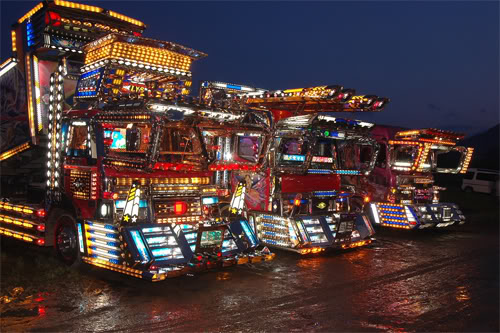
Long thought of as a homogenous culture of cubicle drones, the Japanese can actually be just as creative and weird as anyone. Dekotora (an abbreviation of “decoration truck”) is a perfect example of how individualistic the Japanese can be. Built and owned by independent truckers, dekotora are regular trucks modified to look like the front of a Las Vegas casino. Except not so boring. A tangle of lights, decals, and massive chrome fixtures, these trucks light up the Japanese highways and rest stops as their owners gather to show off their designs. No two trucks are the same and owners take pride in making their trucks as outlandish as possible. Best of all, these trucks are actually used to transport goods.
9. Tourist Buses (Thailand)

Like dekotora in Japan, Thai tourist buses are riots of color and design. Custom painted by professionals who devote their lives to the art, these buses cruise around Thailand decorated with millions of different designs and images. From Disney characters to Japanese anime scenes, nothing is too outlandish or colorful to be masterfully rendered on the side of a bus. In fact, the custom painted buses are so widespread that the only kind of bus that would stand out on the streets of Bangkok is one with a regular paint job. In the tourist bus industry, garish colors and giant cartoon characters are the norm. Say what you want about these buses, but they sure beat getting into some crappy old grey Greyhound.
8. Choppers (U.S.A.)

At the end of World War 2, millions of returning GI’s found themselves back home with a thirst for excitement that postwar life couldn’t satisfy. Many of them purchased motorcycles to enjoy the speed and freedom of the open road, but found the factory versions bulky and full of unnecessary parts. Putting the skills Uncle Sam had taught them to peaceful use, they modified and “chopped” their bikes to make them leaner and faster. Over the next twenty years, the art developed and a huge subculture was born. Although choppers largely faded from the public eye over the years, they saw a resurgence in the 2000’s with shows like American Chopper and brands like West Coast Choppers marketing the customized bikes to a new generation. Highly modified, dangerous and loud; perhaps no other custom vehicle better symbolizes the U.S.A. Which is lucky because that’s the only country in the world where you can legally drive one.
7. Itasha (Japan)

Let’s say you finally have enough money and power to buy that Italian sports car you’ve always dreamed of. A masterpiece of automotive engineering and raw power, it looks just as cool as it feels. Obviously, the first thing you’re going to do is run out and blow a whole bunch more money to have a sexy cartoon character painted on it, right? Strange as it may seem, for a group of car enthusiasts in Japan, that’s exactly what they do. Known as itasha (which means “pain car”- “pain” for “painfully embarrassing” or “painful on the wallet” – really) these cars are primarily owned, operated, and shown off by guys whose love for performance vehicles is matched only by their desire to make love to a cartoon. Although the itasha are starting to be seen in actual races and sponsored by actual companies, it’s still largely a labor of love. For the men who devote a sizable chunk of their pay checks to letting the world know just how much they love that cartoon schoolgirl with the pink hair, no amount is too much.
6. Lowriders (U.S.A.)
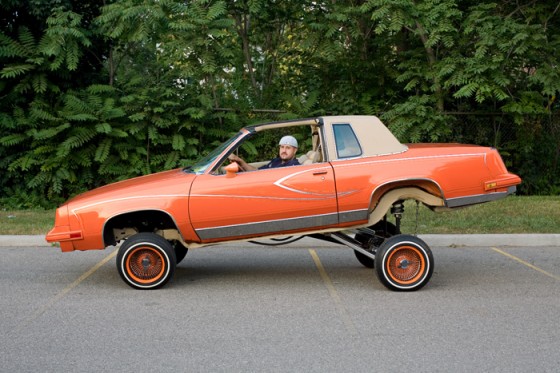
Although they’ve come to be associated with West Coast hip hop culture in recent years, lowriders have always been an integral part of Chicano culture. First built by Mexican Americans as far back as the 30s, lowriders and the culture around them developed and flourished during the postwar boom. Like the ex-soldiers who cut up their choppers, lowrider enthusiasts heavily modified their cars to ride as low as possible. After first using sandbags and cinder blocks, they moved on to actually cutting and shortening their cars. The goal was to be as “low and slow” as possible. One of the most famous lowrider modifications, hydraulics, was actually done as a response to a punitive law enacted by the state of California. Not pleased to have a bunch of what they saw as undesirables driving low and slow through their neighbourhoods, the state made it illegal to have any part of a car lower than its rims. To get around the law, one enterprising customizer took some pumps from an old B-52 bomber and invented a system where he could raise or lower his car depending on whether there were any cops around.
5. Mod Scooters (U.K.)
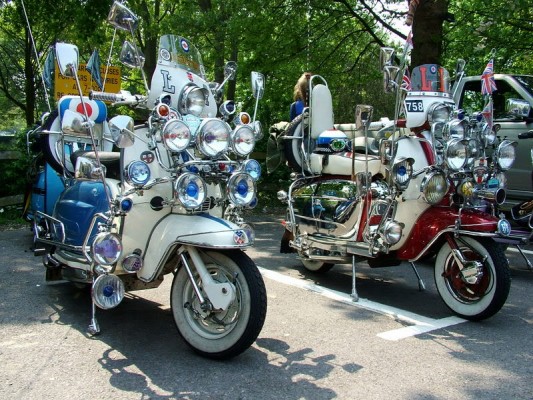
The Swinging Sixties may have produced a lot of great music, but at its heart, it was all about style. From the James Bond dinner jackets to the Emma Peel cat suits, the secret mission in 1960’s London was to look as cool as humanly possible, and to spare no expense doing it. One of the more popular subcultures of the time, the mods, expressed their undying love of fashion in their motor scooters. Although they were largely working class kids, mods were influenced by Italian culture and fashion and loved the cheap, sleek Vespa and Lambretta scooters. Once they got them, they heavily modified their exteriors- especially the mirrors and lights. Not content to limit themselves to just two mirrors or one light, some Mods crammed as many rear-view mirrors and headlights as they could on their scooters. Never before or since in the history of motor vehicles has being safe been so cool.
4. Jingle Trucks (Central Asia)

Though the name may sound silly (and maybe even a little offensive) jingle trucks are nothing to laugh at. These heavily adorned commercial vehicles are common throughout Central Asia, but the most elaborate are found in Afghanistan, India, and Pakistan. Covered in colorful paintings of houses, animals, vehicles, and pastoral landscapes, the jingle trucks are amazing to look at. Despite a common look, each truck is unique and is meant to be a reflection of the owner’s tastes and personality. One image common to most trucks is a human eye, meant to ward off evil spirits. But what sets the jingle trucks apart from other custom vehicles (and gives them their name) is of course the jingling. To get the signature sound, jingle trucks’ bumpers are decorated with long chains and charms hanging like curtains. In the harsh Afghan wind, these chain curtains act as wind chimes, letting everyone know a jingle truck is approaching. That’s if they haven’t yet see the giant painted eye staring at them.
3. Jeepneys (Philippines)
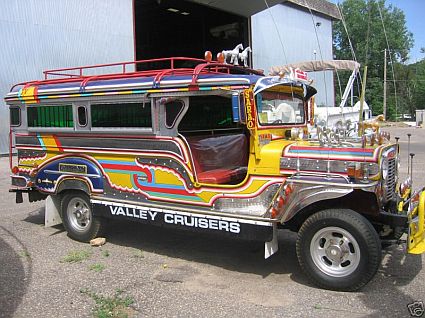
Originally built on the husks of surplus and worn out U.S. Army jeeps, jeepneys are a great example of how one man’s trash is another man’s treasure. When the U.S. army withdrew from the Philippines after World War 2, they sold or gave hundreds of their surplus jeeps to the locals. Happy to have a vehicle, but not so happy to have one designed for transporting soldiers, the Filipinos stripped the jeeps, extended the cabs, added roofs, and painted over the boring army green with all kinds of bright colors. The resulting vehicles were way more fun to look at and served a vital role in re-establishing public transportation in a country still trying to rebuild after years of occupation. They became a part of the culture and still exist today, although they aren’t built from old army jeeps anymore. Some manufacturers have even started to build “e-jeepneys,” jeepneys that run on electricity. These jeepneys of the future will help to ensure that the streets of the Philippines will never be drab, even after the oil runs out.
2. Customized Vans (U.S.A.)

Does anything say “The Seventies” quite like a customized boogie van? Although they first came to prominence among hippies and surfers in the Sixties, custom vans really came into their cheesy own after 1970. Inside, they were mobile living room masterpieces of shag carpeting, strobe lights and if you were really lucky, a mini-fridge full of cold brews and panty peeler. Outside, they were low culture tributes to the heroes of the day. Every sci-fi and fantasy character from Conan to C3PO was immortalized in air-brushed glory for all to see. Custom van culture combined the free-wheeling nomadism of the Sixties with the do-anything-to-feel-good hedonism of the Seventies. Moving fortresses of comfort, they cruised the streets and beaches, bringing all the comforts of home anywhere there was pavement. All that and they had wicked pictures of barbarians kicking major ass.
1. Custom Rickshaws (India, Bangladesh)
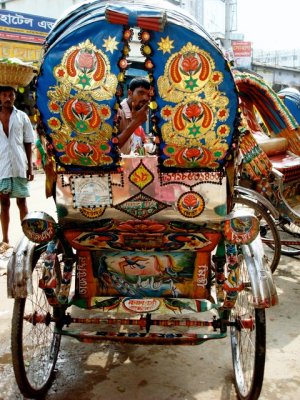
The only human-powered vehicles on the list, the custom rickshaws of India prove that just because your vehicle doesn’t have an engine, doesn’t mean you can’t trick it out. Although their use has largely faded in other parts of the world, rickshaws remain a common form of transportation in many cities in India and Bangladesh. Used as a cheap way to get around, rickshaws are an integral part of the transportation system. But what makes them great is the art. Covered in oil paintings that depict everything from movie stars to products to political commentary, they reflect the owner’s opinions and feelings while giving other people on the road something very cool to look at. In the past, elites looked down on the paintings as gauche examples of low-class culture, but recently artists and scholars have started to take them seriously as an art form. All this, and they’re environmentally friendly!
Subscribe to:
Posts (Atom)






































